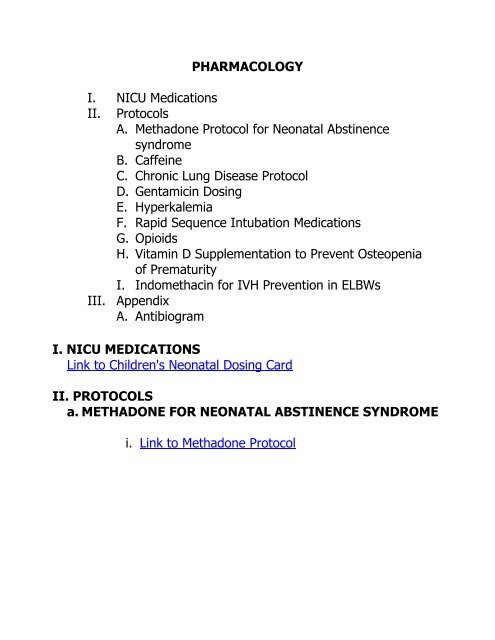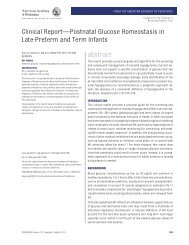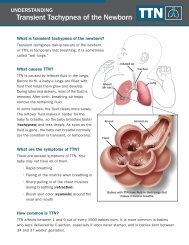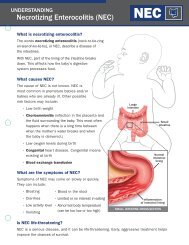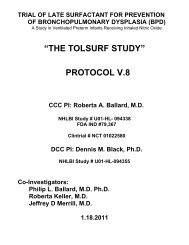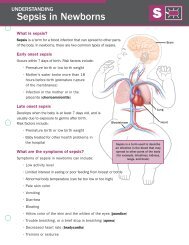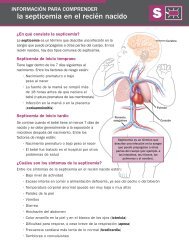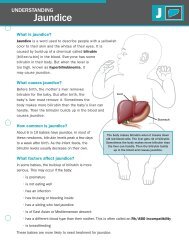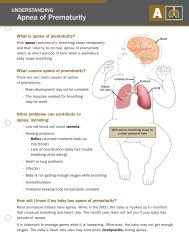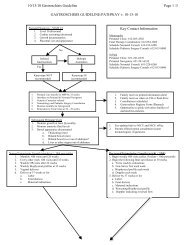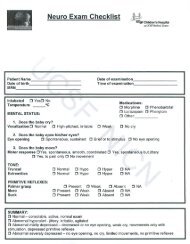NICU-Resident-Manual..
NICU-Resident-Manual..
NICU-Resident-Manual..
- No tags were found...
You also want an ePaper? Increase the reach of your titles
YUMPU automatically turns print PDFs into web optimized ePapers that Google loves.
I. <strong>NICU</strong> MedicationsII.PHARMACOLOGYProtocolsA. Methadone Protocol for Neonatal AbstinencesyndromeB. CaffeineC. Chronic Lung Disease ProtocolD. Gentamicin DosingE. HyperkalemiaF. Rapid Sequence Intubation MedicationsG. OpioidsH. Vitamin D Supplementation to Prevent Osteopeniaof PrematurityI. Indomethacin for IVH Prevention in ELBWsIII. AppendixA. AntibiogramI. <strong>NICU</strong> MEDICATIONSLink to Children's Neonatal Dosing CardII. PROTOCOLSa. METHADONE FOR NEONATAL ABSTINENCE SYNDROMEi. Link to Methadone Protocol
. CAFFEINECAFFEINE CITRATE USE IN VLBW INFANTS
C. CHRONIC LUNG DISEASE PROTOCOLRecommendations for the use of steroids and diuretics in chronic lung disease at > 34weeks CGAAIMS1. Reduce incidence of chronic lung disease (as defined by supplemental O 2 need at36 weeks CGA).2. Provide consistency in diuretic and steroid use among neonatology providers ininfants with CLD and relatively low oxygen requirements.RECOMMENDATIONSInfants at 34 weeks CGA with persistent oxygen need of an effective FiO 2 < 0.3 on lowflow blended nasal cannula will have consideration of the following interventions inattempt to wean off oxygen. Prior to initiation, a discussion with parents regarding thespeculative benefits of these treatments should occur.1. At 34 weeks postmenstrual age: institute a trial of furosemide (Lasix) a 2mg/kg/day po daily x 7 days.If trial results in reduction of oxygen need, consideration should be given toinitiation of long-term chlorothiazide (Diuril) at 40 mg/kg/day (+/- sodiumand potassium supplements.AND/OR2. At 34 weeks postmenstrual age for persistent supplemental oxygen need +/-diuretic trial: institute predinisolone at 1 mg/kg/dose q 8 hours x 72 hours.Infants should be observed for rebound oxygen need for 5-7 days poststeroid use.RELATIVE CONTRAINDICATIONS1. Lasix: hypokalemia or nephrocalcinosis2. Prenisolone/methylprednisolone: hypertensionThese clinical practice reconnendations should be considered as suggested clinical practiceand the choice to pursue these treatment options will remain at the discretion of roundingneonatologist or fellow.Suggested reading:Brion LP, Primhak RA. Intravenous or enteral loop diuretics for preterm infants with (or developing) chroniclung disease. Cochrane Database of Systematic Reviews 2000, Issue 4. Art. No.: CD001453. DOI:10.1002/14651858.CD001453.Bhandari A, et al. Effect of a short course of predisolone in infants with oxygen-dependentbronchopulmonary dysplasia. Pediatrics 2008 121: e344-e349.
D. GENTAMICIN DOSING<strong>NICU</strong> GENTAMICIN DOSING 1,2< 7 days of ageANY Neonate withrenal dysfunction orasphyxia at birth> 7 days of age< 1250 grams > 1250 grams4 mg/kg/dose q 48 hrsLevels if treating > 72 hrsContact Pharmacy to set up levels4 mg/kg/dose q 24 hrsLevels if treating > 72 hrs4 mg/kg/dose – one dose onlyContact Pharmacy for gentamicin levels and maintenance dosing3 mg/kg/dose q 12 - 24 hrsNo gentamicin levels until after culture results are knownGentamicin Dosing Table for infants < 7 days old (round to nearest 0.5 mg):Weight (grams) Dose (mg) Interval (hrs)1000 4 481100 4.5 481200 5 481300 4.5 241400 5.5 241500 6 241600 6.5 241700 7 241800 7.5 241900 7.5 242000 8 242100 7.5 242200 9 242300 9.5 242400 9.5 242500 10 242600 10.5 242700 11 242800 11.5 242900 11.5 243000 12 243100 12.5 243200 13 243300 13.5 243400 14 243500 14 241 Children's Hospitals and Clinics 09/97 – Based on data collected at St Paul 19962 Neofax – 13 th edition. Young TE and Mangum OB. 1999: 32-33.
E. HYPERKALEMIA(Central Serum Potassium 6.5 mEq/l or >) is a medical emergency that requiresclose patient observation, continuous cardiac monitoring, and measurement of serumpotassium levels. Treatment is indicated when serum potassium is greater than 7 mEq/l.Etiology of Hyperkalemia in Neonates• Factitious (most common): Hemolyzed blood from heel stick, thrombocytosis.Send repeat sample STAT before starting treatment, unless EKG changes indicatehyperkalemia.• Decreased removal of potassium: Acute renal failure, positive potassium balancein premature infants during the first days of life, adrenal failure in CAH and medications(Captopril).• Increased load of potassium: Hemoloysis, IVH, hematoma, excess potassiumadministration.• Redistribution: Elevated potassium, secondary to metabolic acidosis and sepsis,NEC, and medications (Digoxin).Evaluation of HyperkalemiaDetermination of etiology and management: Electrolytes, BUN, creatinine, plateletcount, blood gases, ionized calcium, total calcium, and magnesium levels. EKG changesprogress with increasing potassium level: peak T-waves, prolonged PR interval, loss of Pwave, widening QRS, sign wave QRST, first degree AV block, ventricular dysrhythmia and,finally, asystole.Treatment of HyperkalemiaHyperkalemia with dehydration should respond to fluid resuscitation.• Immediately change to an IV solution without potassium. If on gentamicin, hold dose,pending evaluation of renal status, and gentamicin trough levels. The effects ofhyperkalemia can be worsened by hypocalcemia and hypomagnesemia.Hyperkalemia with Cardiac Changes• With cardiac monitoring, give 100 mg/kg/dose (1 ml/kg/dose) IV of 10% calciumgluconate or 20 mg/kg/dose (0.2 ml/kg/dose) of 10% calcium chloride over 10minutes. This will decrease myocardial excitability and prevent cardiac arrhythmias.May repeat calcium dose in 10 minutes, if abnormal cardiac changes persist.Administration of calcium does not lower serum potassium levels.• If patient is acidotic, give sodium bicarbonate, 1-2 mg/kg IV over 10-20 minutes.Inducing alkalosis will drive potassium into cells. Correct respiratory acidosis firstbefore administering sodium bicarbonate.• Give insulin to assist driving potassium into the intracellular fluid compartment. Ifinfant is normoglycemic, administer insulin and glucose together as a bolus to preventhypoglycemia. The ratio should be 1 unit of insulin to 4 gm of glucose given as a
olus. 0.05 units/kg of regular insulin with 2 ml/kg of D10W 10% glucose, followed bycontinuous infusion of D10W at 2-4 cc/kg/hour, and regular insulin, 10 units/100 ml at1 ml/kg/hour. Obtain initial glucose level, and follow glucose levels every 30-60minutes until stable.• Enhance potassium excretion. Give diuretic therapy: Lasix, 1 mg/kg IV, may increasepotassium excretion by increasing flow and sodium delivery to distal tubules.• Kayexalate, rectally (1 gm/kg at 0.5 gm/ml of normal saline) with minimum retentiontime of 30 minutes. The silastic feeding tube should be inserted 1-3 cm for retentionenema. Follow sodium levels because patient will be at risk for hypernatremia with thisexchange resin.• Double-volume exchange with fresh whole blood (less than 24 hours old ordeglycerolized) red blood cells reconstituted with fresh frozen plasma.• Peritoneal dialysis.MANAGEMENT OF HYPERKALEMIA IN VLBW INFANTS1. Maintenance fluids: 80 – 100 cc/kg/day D5W. If blood sugar is > 100 mg%, beginregular insulin normal saline, 0.1 units/kg/hour. Titrate infusion rate to keep bloodsugar 100 – 200 mg%2. Blood sugar should be monitored every hour until stable, then every two hours. Ifblood sugar or if serum potassium continues to rise, increase insulin infusion rateby .05 cc/kg/hr. If blood sugar is < 100 mg%, insulin infusion should be stopped.Any changes in insulin infusion rate should be blood sugar within one hour.3. Additional treatment for hyperkalemia:Sodium bicarbonate, 1 – 3 mEq/kg IV over 3 – 5 minutes;Calcium gluconate (10%), 0.2 – 0.5 cc/kg IV over 2 – 5 minutes.NOTE: Calcium gluconate is not compatible with sodium bicarbonate.F. RAPID SEQUENCE INTUBATION MEDICATIONSRapid sequence intubation medications should be given as a push in the following orderfor all NON-EMERGENT intubations in the <strong>NICU</strong>.1. Atropine 0.1 mg/DOSE2. Morphine 0.1 mg/kg3. Rocuronium 1 mg/kgThe rocuronium typically takes two minutes to go into effect, so do not give a second doseuntil you have waited at least two minutes to see any effect.
G. OPIODSIndividual clinical circumstances may require a change from the suggested guidelines.OPIODS for PAIN or SEDATIONNarcotics should be prescribed for pain control according to our guidelines forpostoperative analgesia and for procedures. There is no concerted effort to not treat pain,particularly post-operatively. However, we should administer analgesics according toguidelines and be mindful of the side effects of prolonged exposure to narcotics.Narcotics should not routinely be used for sedation of infants receiving mechanicalventilation. Alternative drugs for sedation include Ativan and chloral hydrate.Morphine may be a better choice than fentanyl because of less chance of chest wallrigidity or laryngospasm following rapid administration. One study comparing continuousinfusions of morphine and fentanyl in neonates found an average 9.6-day delay indischarge of infants who received fentanyl.Intermittent doses of narcotics are generally preferable to continuous infusions.Continuous infusions predispose an infant to more complications/side effects, including guthypomotility, urinary retention, and addiction. Infusions may be more practical in certainconditions, such as postoperative gastroschisis where both paralysis and prolongednarcotic administration may be needed. High frequency oscillatory ventilation andcongenital diaphragmatic are examples where sedation rather than pain control areimportant.
H. VITAMIN D SUPPLEMENTATION TO PREVENTOSTEOPENIA OF PREMATURITYRecommendationAll infants born at < 34 weeks gestation should be started on Vitamin D 400 IU/dayPO/NG at the time of birth.** This should be initiated regardless if the patient is otherwise NPO **Screening LabsVitamin D panel should be assessed after one month of therapy, and monthly thereafter(goal 25 (OH)-D level > 50 nmol/L). Alkaline phosphatase should be assessed per <strong>NICU</strong>practice.** Vitamin D supplementation will be discontinued if the infant is receiving > 16ounces/day of formula, the alkaline phosphatase is < 400, or the vitamin D laboratoriesindicate excessive levels. **Rationale55% of ELBW infants and 23% of VLBW infants have low bone mineralization due topremature birth. It is reported that up to 25% of VLBW infants have overt fracturesduring their hospitalization. Inadequate calcium and phosphorus as well as inadequatevitamin D levels are major contributors to premature infant metabolic bone disease(rickets/osteopenia). Many pregnant mothers are vitamin D deficient. Infants receive theirvitamin D supply vie the mother in utero and get approximately 50 – 70% of the level ofthe mother.Recommended reading: Taylor SN, Hollis BW, Wagner CL. Vitamin D needs of preterminfants. Neoreviews 2009; 10: e590-e599.I. INDOMETHACIN FOR IVH PREVENTION IN ELBWSRecommendationAll infants born < 1000 gm should have indomethacin prophylaxia initiated at 3 – 6 hoursof life for the prevention of intracranial hemorrhage. Dosing is indomethacin 0.1mg/kg/dose q 24 hrs x 3 doses. First dose should be given between 3 – 6 hours of life.** Routine echocardiogram at 72 hrs of life is no linger warranted and should be obtainedonly if the infant is having signs/symptoms of a patent ductus arteriosus. **** If the infant requires hydrocortisone, dosing should be delayed by 24 hours from themost recent indomethacin dose.
RationaleRecommended reading: Fowlie P, Davis P. Prophylactic indomethacin for preterm infants:a systematic review and meta-analysis. Arc h Dis Child Fetal Neonatal Ed. 2003; 88(6):F464-F466.III. APPENDIX2011 ANTIBIOGRAMa. Link to Children's Antibiotogram 2011


